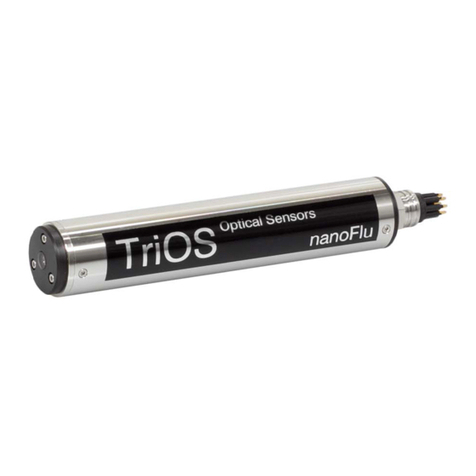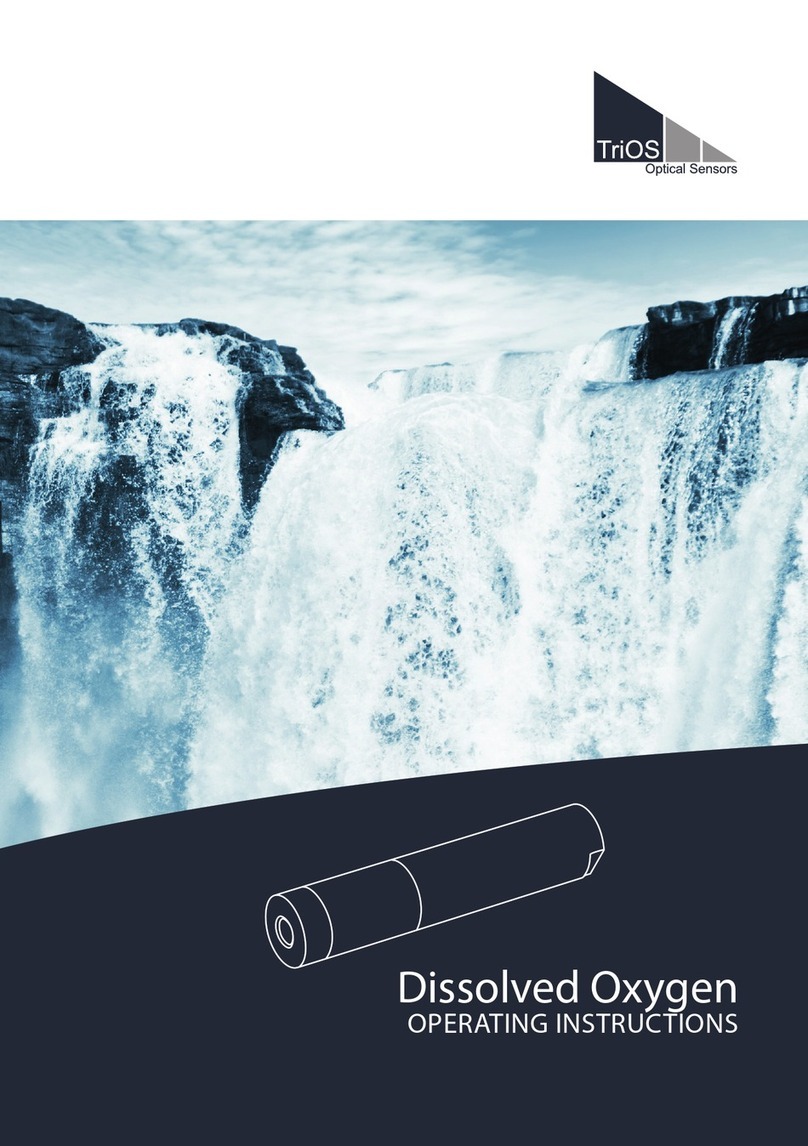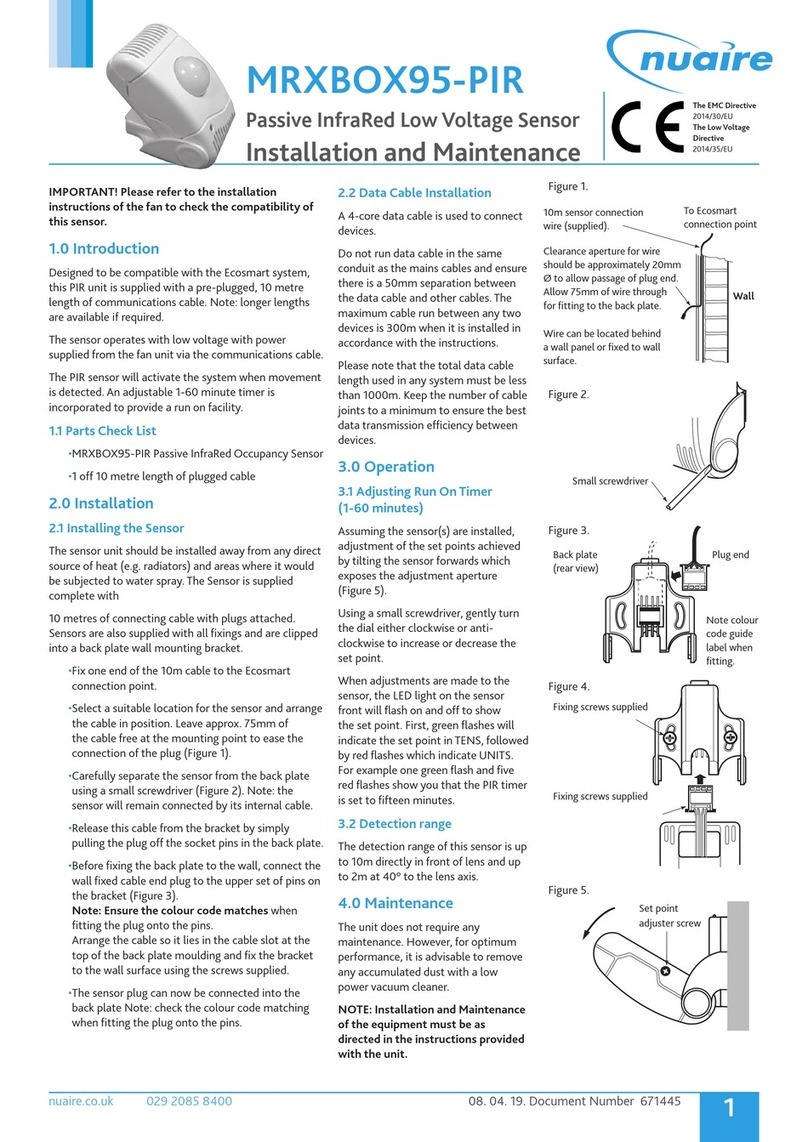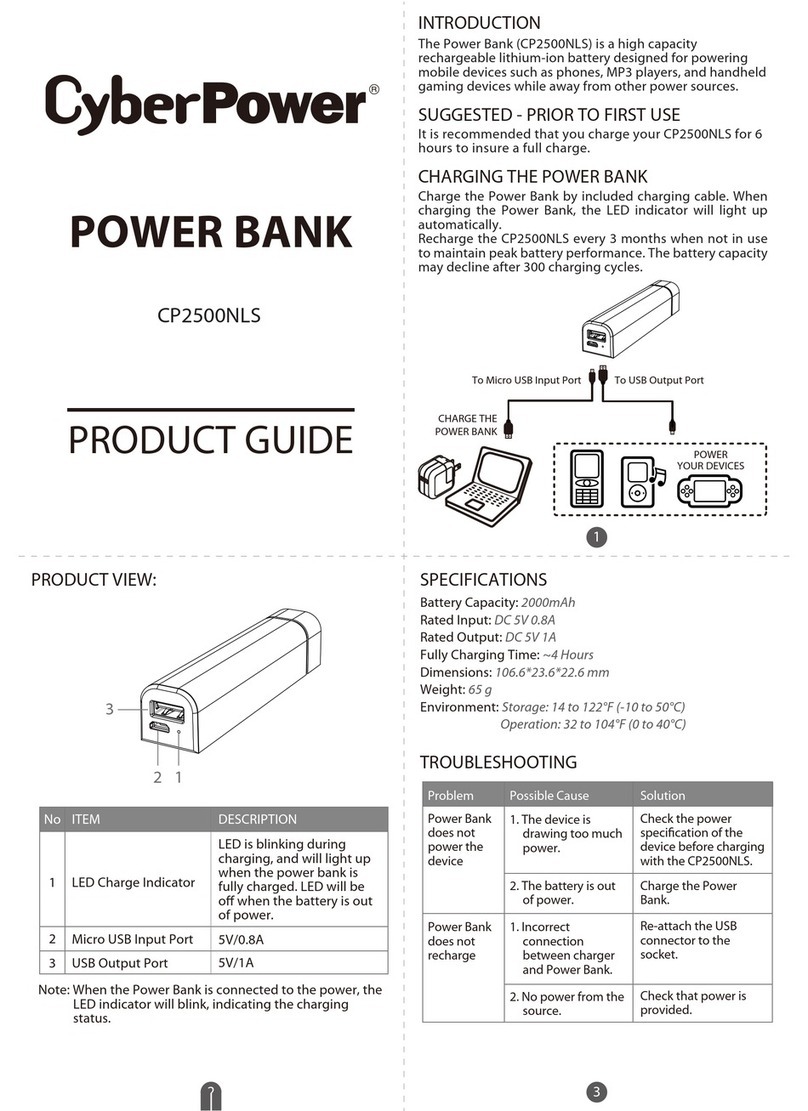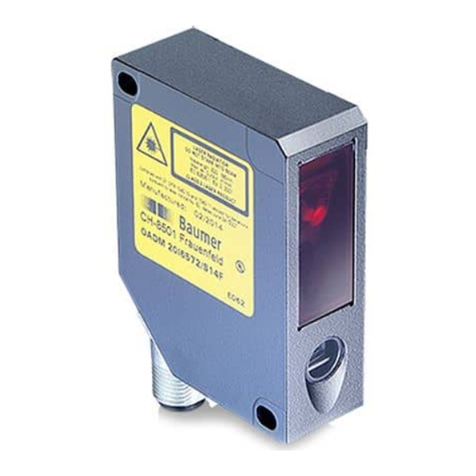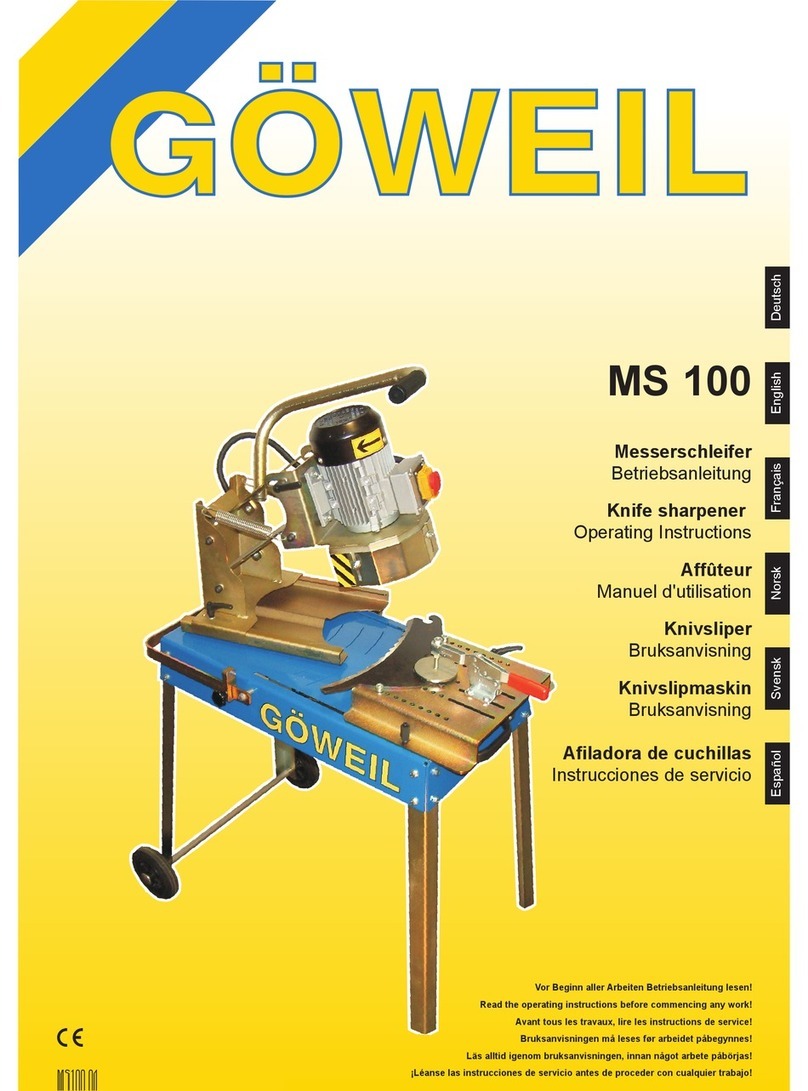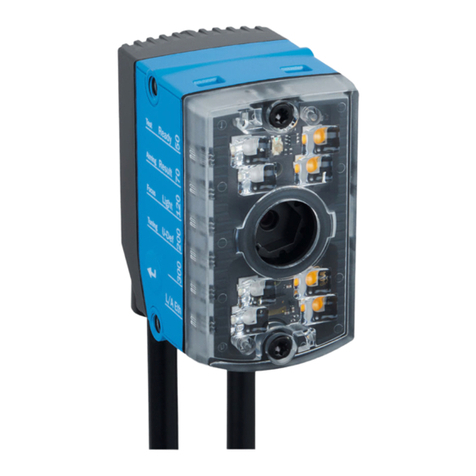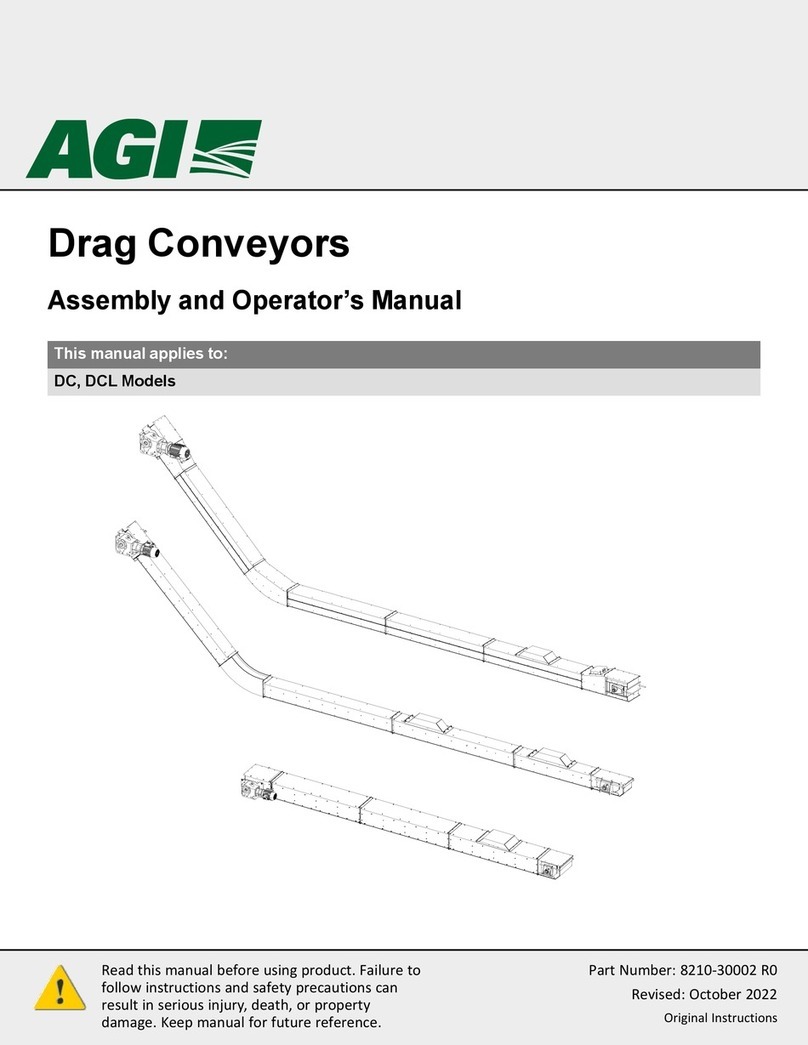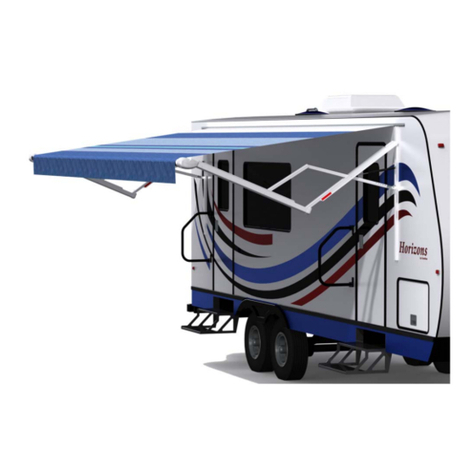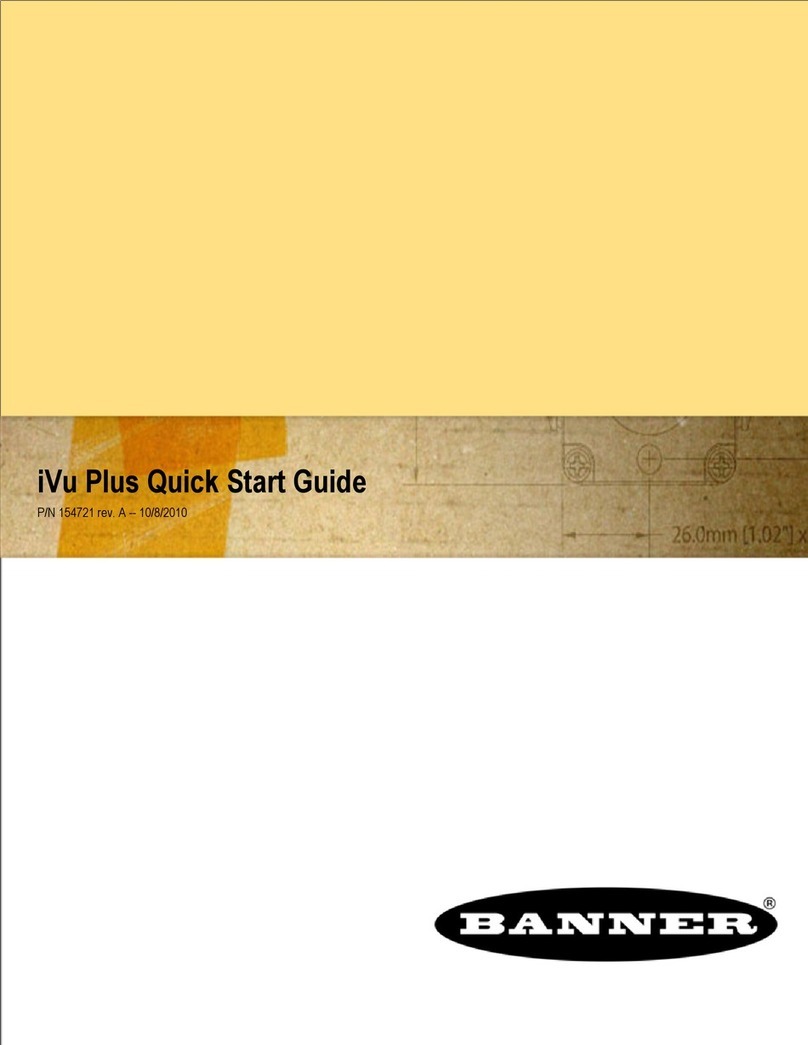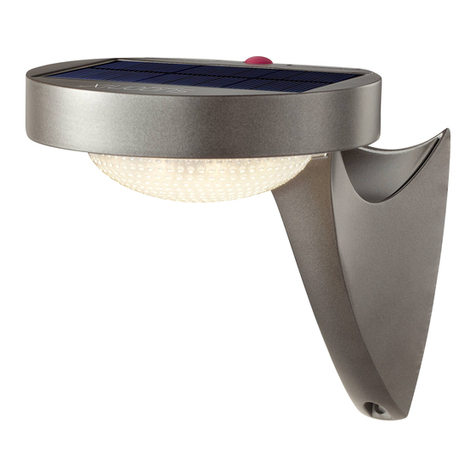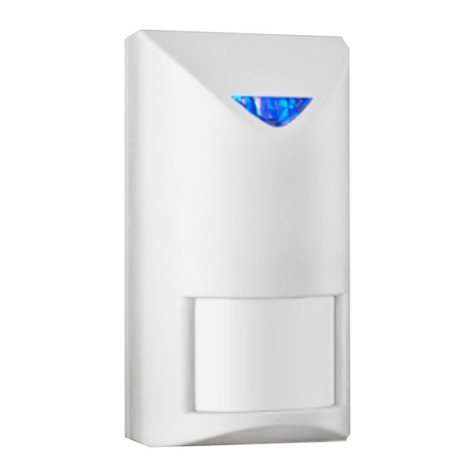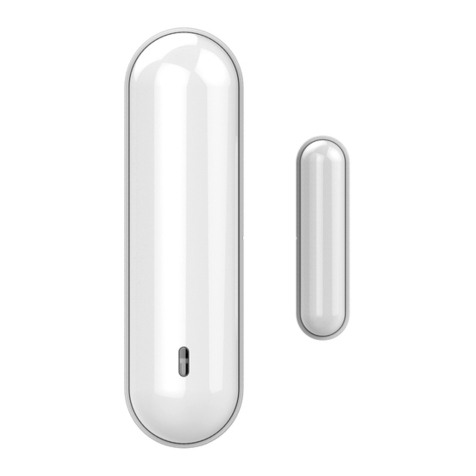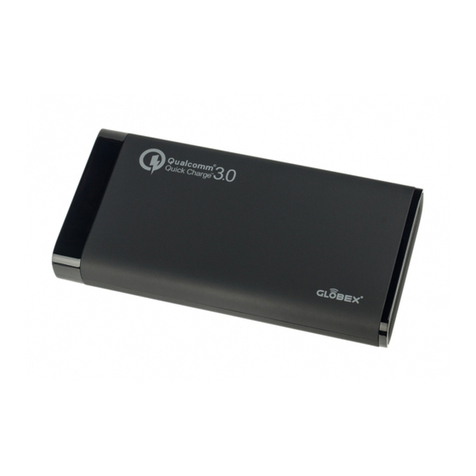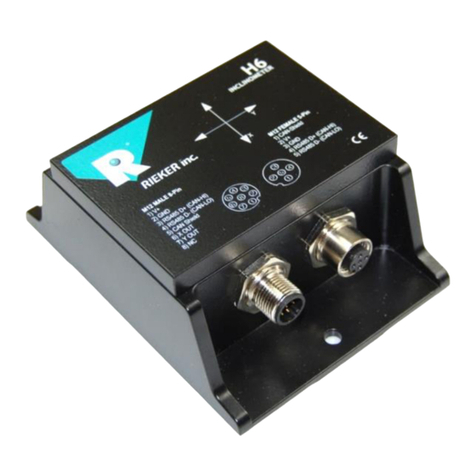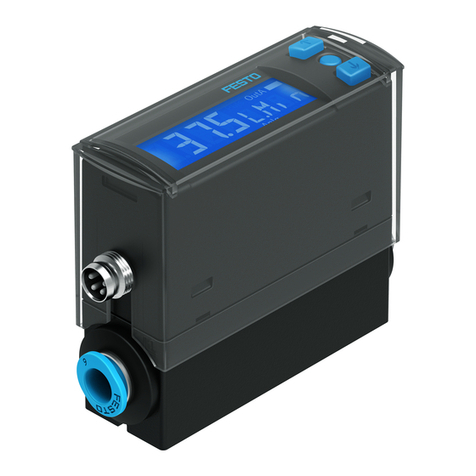triOS eCHEM 90S220000 User manual

Chlorine Dioxide
OPERATING INSTRUCTIONS


1
TABLE OF CONTENTS
Table of Contents
1 General Information 2
1.1 Introduction 2
1.2 Health and safety information 3
1.3 Warnings 4
1.4 Users and Operating Requirements 4
1.5 Intended use 5
1.6 Disposal Information 5
1.7 Certicates and Approvals 5
2 Introduction 6
2.1 Product Identication 6
2.2 Scope of Delivery 7
2.3 Measurement Principle and Design 7
3 Commissioning 8
3.1 Preparation of the Sensor for Commissioning 8
3.2 Electrical installation 10
3.3 Interfaces 11
3.4 Measurement 11
4 Use 12
4.1 Installation with retaining ring in the ow cell 13
5 Calibration 14
5.1 Manufacturer Calibration 14
5.2 Customer calibration 14
5.3 Measurement properties 15
6 Malfunction and Maintenance 16
6.1 Cleaning and Upkeep 16
6.2 Maintenance and inspection 16
6.2.1 Electrolyte Replacement 17
6.2.2 Membrane cap replacement 17
6.2.3 Sensor Check 18
6.2.4 Storage 18
6.3 Troubleshooting 18
6.3.1 General Troubleshooting 19
6.3.2 Special Troubleshooting on the Sensor 22
6.4 Returns 25
7 Technical Data 26
8 Accessories 27
8.1 Controller 27
8.1.1 TriBox3 27
8.1.2 TriBox mini 27
9 Warranty 28
10 Customer service 29
11 Contact 28
12 Keyword Index 32
Annex 34

2
Use
Use
Calibration
Calibration
Malfunction and
Maintenance
Malfunction and
Maintenance
Comm-
issioning
Comm-
issioning
Introduction
Introduction
General
Information
General
Information
FAQ
FAQ
Technical
Data
Technical
Data
Warranty
Warranty
Customer
service
Customer service
Contact
Contact
Keyword
Index
Keyword
Index
Accessories
Accessories
D01-915en201911 Manual eCHEM Chlorine Dioxide
General Information // Chlorine Dioxide
1.1 Introduction
Welcome to TriOS.
We are glad that you have chosen to purchase our chlorine dioxide sensor.
The chlorine dioxide sensor from the eCHEM sensors product range is an electrochemical sensor for measuring the chlorine
dioxide concentration in water. The range of application of the sensor covers almost all water qualities and treatments (e.g.
bottle washing machine, CIP system, rinser). It can also be used in seawater. Thanks to a special membrane system, the sensor
is particularly resistant to chemicals and surfactants.
In this manual, you will primarily only nd information you will need to commission the eCHEM chlorine dioxide sensor. Tech-
nical specications can be found in chapter 7. The corresponding operating instructions of the peripheral devices must be
observed.
Please note that the user is responsible to comply with local and state regulations for the installation of electronic equipment.
Any damage caused by incorrect use or unprofessional installation will not be covered by the warranty. All sensors and ac-
cessories supplied by TriOS Mess- und Datentechnik GmbH must be installed and operated in accordance with the specica-
tions provided by TriOS Mess- und Datentechnik GmbH. All parts were designed and tested in accordance with international
standards on electronic instruments. The device meets the requirements of the international standards on electromagnetic
compatibility. Please use only original TriOS accessories and cables to ensure reliable and correct operation of the devices.
Before using the device, read the manual carefully, and keep this manual on hand for future reference. Before commissioning
the sensor, please make sure that you have read and understood the following safety precautions. Always make sure that the
sensor is operated correctly. The safety precautions described on the following pages should ensure the reliable and correct
operation of this device and any additional associated devices and should prevent injuries to yourself or other persons and
damage to other equipment.
1 General Information
If the translation is at all dierent from the original German text, the German version is binding.
Copyright Notice
All of the content in this manual, including texts, photographs and graphics, are protected by copyright. Unless expressly
stated otherwise, TriOS Mess- und Datentechnik GmbH is the owner of the copyright. Persons who violate the copyright shall
be liable pursuant to § 106 et seq of the copyright law, they will be warned at their own expense and must pay compensation.
NOTICE

3
Use
Use
Calibration
Calibration
Malfunction and
Maintenance
Malfunction and
Maintenance
Comm-
issioning
Comm-
issioning
Introduction
Introduction
General
Information
General
Information
FAQ
FAQ
Technical
Data
Technical
Data
Warranty
Warranty
Customer
service
Customer service
Contact
Contact
Keyword
Index
Keyword
Index
Accessories
Accessories
D01-915en201911 Manual eCHEM Chlorine Dioxide
Chlorine Dioxide // General Information
1.2 Health and safety information
This manual contains important information about health and safety rules. This information is labelled according to the in-
ternational specications of ANSI Z5356 ("Product safety information in product manuals, instructions and other collateral
materials") and must be strictly followed. The following are distinct categories:
Electromagnetic waves
Devices that radiate strong electromagnetic waves can inuence the measurement data or result in a malfunction of the sen-
sor. Avoid using the following devices in the same room as the TriOS sensor: mobile phones, cordless phones, transmitters/
receivers and other electrical devices that produce electromagnetic waves.
Reagents
Follow the safety and operating instructions of the manufacturer when using reagents. Observe the valid Hazardous Materials
Ordinance for reagents (German GefStoV)!
Biological safety
Liquid waste may be a biohazard. Therefore, you should always wear gloves when working with such materials. Please observe
the currently valid biological agents regulation! (German BioStoV)
Waste
When handling liquid waste, observe the regulations on water pollution, drainage and waste disposal.
Tip / Useful Information
Can result in damage to property
Warning / may lead to serious injury or death
Caution / may cause moderate injury
Danger warning / will lead to serious injury or death
DANGER
WARNING
CAUTION
NOTICE

4
Use
Use
Calibration
Calibration
Malfunction and
Maintenance
Malfunction and
Maintenance
Comm-
issioning
Comm-
issioning
Introduction
Introduction
General
Information
General
Information
FAQ
FAQ
Technical
Data
Technical
Data
Warranty
Warranty
Customer
service
Customer service
Contact
Contact
Keyword
Index
Keyword
Index
Accessories
Accessories
D01-915en201911 Manual eCHEM Chlorine Dioxide
General Information // Chlorine Dioxide
1.3 Warnings
• The sensor should only be used in drinking water, swimming pool water or sea water, other water qualities should
be tested.
• Any other use is considered improper. In the event of improper use, all warranty claims are void and liability is
excluded.
• The sensor may only be used to determine and control the chlorine dioxide concentration.
• The sensor is not suitable for checking the absence of chlorine dioxide.
• The material resistance should be tested for each application.
• Do not cut, damage or change the cable. Make sure that no heavy objects are placed on the cable and that the
cable is not kinked. Make sure that the cable is not run near hot surfaces.
• Do not place any unsuitable objects near the measuring head as long as the measurement process is running,
as this can cause damage to the membrane or incorrect measurement results.
• Stop operation of the sensor in the event of excessive heat development (i.e. if it is hot to the touch). Switch
o the sensor immediately and remove the cable from the power supply. Please contact your dealer
or the TriOS customer service.
• Never try to disassemble or modify the electrode body of the sensor if such a procedure is not explicitly
described in this manual. Inspections, modications and repairs may only be carried out by the dealer or
by qualied experts authorized by TriOS.
• If the associated cable is damaged, it must be replaced with an original part by the customer service of
TriOS GmbH.
• When installing the sensor outside Germany, the relevant national regulations must be
observed.
• No liability is assumed for personal injury or damage to property resulting from non-observance of these
operating instructions, modication of the sensor or its improper use.
• Devices from TriOS Mess- und Datentechnik GmbH meet the highest safety standards. Repairs to
the device (which involve the replacement of the connecting cable) must be carried out by
TriOS Mess- und Datentechnik GmbH or by a workshop authorized byTriOS. Defective, improper repairs can lead to
accidents and injuries.
Do not touch the electrode nger or otherwise contaminate it! Do not remove the coating of the
electrode nger!
1.4 User and Operating Requirements
The chlorine dioxide sensor has been developed for use in industry and science.The implementation of chlorine dioxide deter-
mination with test kits often requires the handling of hazardous substances.
We assume that the operating personnel are familiar with dealing with dangerous substances based on their professional
training and experience. The operating personnel must be able to correctly understand and implement the safety labels and
information on the packaging and in the package inserts of the test kits.
TriOS does not guarantee the plausibility of the measured values. The user is always responsib-
le for the monitoring and interpretation of the measured values.
NOTICE
DANGER

5
Use
Use
Calibration
Calibration
Malfunction and
Maintenance
Malfunction and
Maintenance
Comm-
issioning
Comm-
issioning
Introduction
Introduction
General
Information
General
Information
FAQ
FAQ
Technical
Data
Technical
Data
Warranty
Warranty
Customer
service
Customer service
Contact
Contact
Keyword
Index
Keyword
Index
Accessories
Accessories
D01-915en201911 Manual eCHEM Chlorine Dioxide
Chlorine Dioxide // General Information
1.5 Intended use
The purpose of the eCHEM chlorine dioxide sensor is exclusively to measure the chlorine dioxide
concentration as described in this manual. The chlorine dioxide sensor should only be used in conjunction with a ow cell.
Please note the technical data of the accessory parts. Other uses do not comply with the intended use.
The sensor may only be used for the measurement of chlorine dioxide in aqueous uids such as drinking water, swimming
pool water or sea water. Use in other media can damage the sensor. For the use of the chlorine dioxide sensor in other media
than those specied in this manual, please contact the customer service of TriOS Mess- und Datentechnik GmbH (support@
trios. de).
According to current scientic knowledge, the device is safe to use when it is handled according to the instructions in this
user manual.
Avoid any contact with the membrane that could scratch or dirty it. This would no longer guarantee
the functionality of the device.
1.6 Disposal Information
At the end of the device’s life or use, the device and its accessories can be returned for environmentally friendly disposal for a
fee (see addressbelow). The preceding professional decontamination of the device must be proven with a certicate. Please
contact us for more details before you send the device back.
Address of the dealer:
TriOS Mess- und Datentechnik GmbH
Bürgermeister-Brötje-Str. 25
D-26180 Rastede
Germany
Telephone: +49 (0) 4402 69670 - 0
Fax: +49 (0) 4402 69670 – 20
1.7 Certicates and Approvals
This product meets all of the requirements of the harmonised European standards. It therefore meets the legal requirements
of the EU guidelines. TriOS Mess- und Datentechnik GmbH conrms the successful testing of the product by axing the CE
marking. (See Annex.)
NOTICE

6
Use
Use
Calibration
Calibration
Malfunction and
Maintenance
Malfunction and
Maintenance
Comm-
issioning
Comm-
issioning
Introduction
Introduction
General
Information
General
Information
FAQ
FAQ
Technical
Data
Technical
Data
Warranty
Warranty
Customer
service
Customer service
Contact
Contact
Keyword
Index
Keyword
Index
Accessories
Accessories
D01-915en201911 Manual eCHEM Chlorine Dioxide
Introduction // Chlorine Dioxide
2 Introduction
2.1 Product Identication
All TriOS Mess- und Datentechnik GmbH products have a label, which clearly shows the product designation.
There is also a rating plate on the sensor with the following information that you can use to uniquely identify the product:
Serial number
Product type
Power supply
Interface
In addition to the product bar code, the rating plate includes the TriOS Mess- und Datentechnik GmbH logo and the quality
label.
Please note that the specications given here are for illustration purposes only and may be dierent depending on the version
of the product.

7
Use
Use
Calibration
Calibration
Malfunction and
Maintenance
Malfunction and
Maintenance
Comm-
issioning
Comm-
issioning
Introduction
Introduction
General
Information
General
Information
FAQ
FAQ
Technical
Data
Technical
Data
Warranty
Warranty
Customer
service
Customer service
Contact
Contact
Keyword
Index
Keyword
Index
Accessories
Accessories
D01-915en201911 Manual eCHEM Chlorine Dioxide
Chlorine Dioxide // Introduction
2.2 Scope of Delivery
The shipment contains the following components:
- Sensor with membrane cap M10.1N
- 100 ml gel electrolyte ECD4/W*ECD7/W
- Fine sandpaper S2
- 1 G-holder with O-ring
- Tweezers
- Operating instructions
Keep the original packaging of the device in case it needs to be returned for repairs.
2.3 Measurement Principle and Design
The chlorine dioxide sensor is a membrane-covered am-
perometric 2-electrode sensor. The measuring electrode is
covered by a membrane and, together with the combined
counter and reference electrode, is located in an electrolyte
chamber separated from the sample water, which contains a
special gel electrolyte.
In this measuring method, chlorine dioxide diuses from the
sample water through the membrane. When the chlorine
dioxide combines with the electrolyte at the measuring elec-
trode, an electrical signal is triggered. This signal is proporti-
onal to the chlorine dioxide concentration and is amplied
by the sensor electronics. Due to an integrated temperature
compensation, the measuring signal is independent of the
temperature of the sample water. Surfactants are tolerated
as far as possible.

8
Use
Use
Calibration
Calibration
Malfunction and
Maintenance
Malfunction and
Maintenance
Comm-
issioning
Comm-
issioning
Introduction
Introduction
General
Information
General
Information
FAQ
FAQ
Technical
Data
Technical
Data
Warranty
Warranty
Customer
service
Customer service
Contact
Contact
Keyword
Index
Keyword
Index
Accessories
Accessories
D01-915en201911 Manual eCHEM Chlorine Dioxide
Commissioning // Chlorine Dioxide
3 Commissioning
This chapter deals with the commissioning of the chlorine dioxide sensor. Please pay particular attention to this section and
follow the safety precautions to protect the sensor from damage and yourself from injury. Prior to electrical installation (chap-
ter 3.2) of the sensor, it must rst be lled with gel electrolyte as described in chapter 3.1.
Before the sensor can be put into operation, it must be ensured that the sensor is securely attached and all connections are
correctly made.
The following installation requirements must be met:
• Permanent power supply and presence of sample water
• Flow rate according to data sheet
• Constant ow rate
• Disinfectant must be present in the sample water.
• Galvanic isolation of the electrical connection (if not present in the sensor)
• The sample water must not outgas at the measuring point.
3.1 Preparation of the Sensor for Commissioning
Some electrolytes contain diluted acids. Therefore, observe the warning notices on the
electrolyte bottle. Do not swallow the gel electrolyte. In case of skin or eye contact with the
electrolyte, rinse the aected areas thoroughly with water. Consult an ophthalmologist if the
eyes are reddened.
Gel electrolytes must not be shaken and must be stored upside down or on the sealing cap after
opening.
Remove the protective cap [3] from the membrane
cap [2].
Unscrew the membrane cap [2] from the sensor
body [1].
1
2
3
2.
1.
NOTICE
CAUTION

9
Use
Use
Calibration
Calibration
Malfunction and
Maintenance
Malfunction and
Maintenance
Comm-
issioning
Comm-
issioning
Introduction
Introduction
General
Information
General
Information
FAQ
FAQ
Technical
Data
Technical
Data
Warranty
Warranty
Customer
service
Customer service
Contact
Contact
Keyword
Index
Keyword
Index
Accessories
Accessories
D01-915en201911 Manual eCHEM Chlorine Dioxide
Chlorine Dioxide // Commissioning
Place the membrane cap on a clean surface and ll to the rim
with gel electrolyte.
Place the G-holder on a clean surface with the fabric facing
down and moisten the G-holder with gel electrolyte.
Use the tweezers [1] to grasp the G-holder [2] with the fabric
facing down and place the G-holder centrally on the memb-
rane in the membrane cap [3].
Carefully pull the tweezers out of the membrane cap again.
The G-holder is now placed in the membrane cap.
Place the sensor body [1] upright on the membrane cap [2]
and turn it counterclockwise until the thread is engaged.
Slowly screw the sensor body into the membrane cap.
Make sure that the membrane cap is completely screwed onto the sensor body, i.e. as far as it will go.
Neither touch nor strike the membrane!
The sensor is ready for commissioning.
1
2
3
1
2
Rinse o electrolyte residues adhering to the outside of the
sensor with tap water.
NOTICE

10
Use
Use
Calibration
Calibration
Malfunction and
Maintenance
Malfunction and
Maintenance
Comm-
issioning
Comm-
issioning
Introduction
Introduction
General
Information
General
Information
FAQ
FAQ
Technical
Data
Technical
Data
Warranty
Warranty
Customer
service
Customer service
Contact
Contact
Keyword
Index
Keyword
Index
Accessories
Accessories
D01-915en201911 Manual eCHEM Chlorine Dioxide
Commissioning // Chlorine Dioxide
3.2 Electrical installation
The chlorine dioxide sensor is equipped with an 8-pin M12 screw connector for electrical commissioning. The following gure
shows the pin assignment of the connector:
1. RS-485 A (commands)
2. RS-485 B (data)
3. Not assigned
4. Not assigned
5. Not assigned
6. Not assigned
7. Ground (Power + Ser. Interface)
8. Power (9...30 VDC)
Insert the connector into one of the suppliedTriOS cables. Connect the male end of the cable into the connector on the sensor
by making the pins align with the slots of the cable. The next step is to turn the locking sleeve clockwise to secure the end of
the connector.
The sensor may only be operated with the specied supply voltage.
Make sure that the supply voltage of the controller is constant! A supply voltage that is too low causes an incorrect measured
value and can lead to dangerous over-metering in a control loop. The sensors must be operated potential-free. There must be
no current ow between the sensors and the measuring medium. Measuring and control devices must therefore have galvanic
isolation.

11
Use
Use
Calibration
Calibration
Malfunction and
Maintenance
Malfunction and
Maintenance
Comm-
issioning
Comm-
issioning
Introduction
Introduction
General
Information
General
Information
FAQ
FAQ
Technical
Data
Technical
Data
Warranty
Warranty
Customer
service
Customer service
Contact
Contact
Keyword
Index
Keyword
Index
Accessories
Accessories
D01-915en201911 Manual eCHEM Chlorine Dioxide
Chlorine Dioxide // Commissioning
3.3 Interfaces
The chlorine dioxide sensor with digital signal processing has a digital Modbus RTU interface (RS-485). The pin assignment has
already been explained in more detail in chapter 3.
The interface must be congured as follows:
• Baud rate: 9600 bps
• Data bits: 8
• Stop bits: 1
• Parity: none
• Flow control: none
A detailed description of the Modbus protocol commands can be found in the Annex.
3.4 Measurement
The sensor must be used for measurements in the ow cell type FLC (see chapter 4). The use of the sensor in other ow cells
must be approved byTriOS GmbH. Otherwise, no warranty will be given for the proper functioning of the sensor or for resulting
damage to property or personal injury.
The maximum permissible operating pressure of the sensor is 1.0 bar (with retaining ring). The permissible temperature ope-
rating range of the sensor is 0 to <50 °C. The sensor may only be used to determine and control the chlorine dioxide concen-
tration.
As soon as the sensor is supplied with power, it starts measuring automatically. The measured values can be displayed, conver-
ted or stored using a TriOS controller.
Please also refer to the corresponding controller manuals! If the sensor is not recognized by the controller, the conguration of
the interface should be checked directly (see chapter 3.3).

12
Use
Use
Calibration
Calibration
Malfunction and
Maintenance
Malfunction and
Maintenance
Comm-
issioning
Comm-
issioning
Introduction
Introduction
General
Information
General
Information
FAQ
FAQ
Technical
Data
Technical
Data
Warranty
Warranty
Customer
service
Customer service
Contact
Contact
Keyword
Index
Keyword
Index
Accessories
Accessories
D01-915en201911 Manual eCHEM Chlorine Dioxide
Use // Chlorine Dioxide
4 Use
The chlorine dioxide sensor can be operated with all TriOS controllers. Instructions for correct installation can be found in the
relevant controller manual.
A bypass installation of the sensor is essential for correct results. Therefore we strongly recommend to use the sensor in the
ow cell type FLC for permanent use.
Before installing the sensor in the ow cell type FLC, make sure that there is no pressure in the system. Close the shut-o valves
upstream and downstream of the ow-through tting. Push the sensor slowly into the ow-through tting. The sensor must
not be pushed against the bottom of the tting.
The use of the sensor without ow cell is not recommended and can lead to loss of warranty.
Screw connection 1 1/4”
Approx. 122
80.00
Dimensions in mm
18.00 44.00
OUT
IN
30.00 100.00
175.00
Approx. 220
Flow control
Sampling
6/8 mm hose
6/8 mm hose
NOTICE

13
Use
Use
Calibration
Calibration
Malfunction and
Maintenance
Malfunction and
Maintenance
Comm-
issioning
Comm-
issioning
Introduction
Introduction
General
Information
General
Information
FAQ
FAQ
Technical
Data
Technical
Data
Warranty
Warranty
Customer
service
Customer service
Contact
Contact
Keyword
Index
Keyword
Index
Accessories
Accessories
D01-915en201911 Manual eCHEM Chlorine Dioxide
Chlorine Dioxide // Use
A sudden failure of the sensor can lead to dangerous over-metering. Take appropriate precautions in
this case! Check system for odour, check water for abnormal discolouration. In case of strong over-
metering, the DPD-1 measurement can remain colourless because the dye is bleached by the chlorine
present.
4.1 Installation with retaining ring in the ow cell
For installation in a ow cell, you need the sensor for chlorine dioxide measurement on the one hand and the ow cell on the
other.
1. To install the sensor in the ow cell, you must rst remove the screw connections on the ow cell FLC.
2. Push the slide ring from the FLC under the retaining ring of the sensor.
3. Push the 25x2.5 O-ring (silicone) underneath the slidw ring over the sensor (see gure).
Make sure that the sensor is prepared as described in chapter 3.
Make sure that the 30x2.6 O-ring (Viton) is still in the ow cell at the insertion edge.
4. Now slowly insert the prepared sensor into the ow cell as shown in the gure.
5. Carefully slide the screw connection over the sensor and screw it tight, otherwise leaks may occur!
6. Open the sample water drain.
7. Slowly open the sample water inlet.
Avoid installations where air bubbles can form in the sample water.
Operating mode Flow-through tting Max. operating
pressure
Max. operating tempe-
rature Flow rate
Sensor operation with
retaining ring FLC 1.0 bar (10 mH2O) 50 °C 15-30 L/h
IMPORTANT Observe and adhere to the max. permitted operating pressure / operating temperature of the
sensor!
Anschlußbuchse
connector
Elektrodenschaft mit
integrierter Elektronik
electrode shaft
with amplifier
Sicherungsring, retaining ring
Gleitring, slide ring
O-Ring
1_17_02_ZB.skd
Connection socket M12 plug
Electrode shaft
with integrated
electronics
Retaining ring
Slide ring
O-ring
Sensor
Screw connection 1 1/4“
Retaining ring
Slide ring
O-ring 25x2.5 (silicone)
O-ring holder
O-ring 30x2.6 (Viton)
FLC
NOTICE

14
Use
Use
Calibration
Calibration
Malfunction and
Maintenance
Malfunction and
Maintenance
Comm-
issioning
Comm-
issioning
Introduction
Introduction
General
Information
General
Information
FAQ
FAQ
Technical
Data
Technical
Data
Warranty
Warranty
Customer
service
Customer service
Contact
Contact
Keyword
Index
Keyword
Index
Accessories
Accessories
D01-915en201911 Manual eCHEM Chlorine Dioxide
Calibration // Chlorine Dioxide
5 Calibration
5.1 Manufacturer Calibration
No manufacturer calibration is performed due to application-related changes in measured values (pH, inow velocity, etc.)The
sensors are only tested under standard conditions (concentration, pH, inow velocity etc.) in an endurance test.
5.2 Customer calibration
A customer calibration using the DPD-1 method ("chlorine dioxide") must be carried out in the application. The installation and
other conditions must match the nal application.
Recommendation: Weekly control, if necessary more frequently. In case of a necessary recalibration, operation with a TriOS
controller is recommended. An integrated wizard guides the user step by step through a calibration menu. The value determi-
ned analytically in parallel by the DPD method is set as the reference value in the controller.
Please note the following explanations for direct Modbus access:
Calibration
The values for zero point (X_Null), slope (X_Span) and then date and time are written to the sensor. The sensor electronics
accepts the new calibration data if the date stamp is sent within approx. 5 seconds following the values. If the date diers from
that of the last calibration, the new values are stored in the history memory and the oldest values are overwritten.
Date / Time stamp
• Data type: unsigned long
• 232 = 4294967296
• Year: (20)42, Month: [94], Day [96], Hour [72], Min: [96]
• Last possible date: 31.12.2042, 23:59
The determination of chlorine dioxide is also possible with a photometer for chlorine if the result is multiplied
by the factor 1.9.

15
Use
Use
Calibration
Calibration
Malfunction and
Maintenance
Malfunction and
Maintenance
Comm-
issioning
Comm-
issioning
Introduction
Introduction
General
Information
General
Information
FAQ
FAQ
Technical
Data
Technical
Data
Warranty
Warranty
Customer
service
Customer service
Contact
Contact
Keyword
Index
Keyword
Index
Accessories
Accessories
D01-915en201911 Manual eCHEM Chlorine Dioxide
Chlorine Dioxide // Calibration
5.3 Measurement properties
The following instructions must be observed when operating the sensor:
• The sensor must be operated in an upright position so that the incoming ow of sample water comes from
below up against the membrane.
• Outgassing sample water interferes with the measurement. During unpressurised operation with free outow
of the sample water gas bubbles have no disturbing eect as long as they do not cover the membrane. Gas
bubbles in front of the membrane prevent the chlorine dioxide from entering the gel electrolyte, which falsies
the measuring signal.
• A minimum inow velocity (>15 L/h) is required. The ow rate must be constant.
• The service life of the membrane is typically 1 year, but it depends very much on the water quality. Heavy soiling
of the membrane must be avoided.
• The supply voltage of the sensor must not be switched o during interval operation of the measuring
system. The sensor must be permanently connected to the supply voltage. The sensor must not stand dry.
• The sensor must not be operated for a longer period of time (>1 day) in chlorine dioxide free water. There is a risk
that deposits/soiling (e.g. biological) will form on the membrane, which makes later chlorine dioxide
measurement impossible. After operating the sensor in chlorine-dioxide-free water, longer stabilization times
must be expected. If required, re-dosing should take place with a time delay. If no chlorine dioxide is expected
over a longer period of time, the sensor must be separated from the controller, removed and stored in a dry place.
• The presence of reducing and oxidizing agents as well as corrosion inhibitors can interfere with the
measurement.

16
Use
Use
Calibration
Calibration
Malfunction and
Maintenance
Malfunction and
Maintenance
Comm-
issioning
Comm-
issioning
Introduction
Introduction
General
Information
General
Information
FAQ
FAQ
Technical
Data
Technical
Data
Warranty
Warranty
Customer
service
Customer service
Contact
Contact
Keyword
Index
Keyword
Index
Accessories
Accessories
D01-915en201911 Manual eCHEM Chlorine Dioxide
Malfunction and Maintenance // Chlorine Dioxide
6 Malfunction and Maintenance
To ensure error-free and reliable measurement, the chlorine dioxide sensor should be cleaned and serviced at regular intervals.
When carrying out maintenance and in the event of a malfunction, the entire system from the extraction point to the drain
must always be taken into account. The system usually consists of:
• Chlorine dioxide sensor
• Electrical wiring and connections
• Flow-through ttings and connections
• Measuring and / or control device
• Dosing device
• Analysis kit
Before removing the sensor, downstream controllers should be switched o or switched to manual operation. If the sensor is
removed, an incorrect measured value may occur at the input of the controller and lead to uncontrolled dosing in a control
loop. Shut o the sample water inlet and outlet. Remove the electrical connection.
6.1 Cleaning and Upkeep
To ensure a long service life of the chlorine dioxide sensor, it should be checked regularly for contamination. Carefully rinse
o any soiling on the outside with water. In case of heavy soiling it is recommended to change the gel electrolyte and/or the
membrane cap. A detailed description on how to change the gel electrolyte and the membrane cap is given in the following
chapter 6.2.
If you have further questions on this topic, we would be pleased to help you. Please contact our customer service at support@
trios.de.
6.2 Maintenance and inspection
The sensor should be checked regularly for contamination, fouling and bubbles on the outside of the membrane. Avoid con-
tamination of the membrane with particles, condensation etc. as far as possible. Bubbles on the outside of the membrane can
be eliminated by briey increasing the ow rate.
After a membrane cap or electrolyte change, a slope adjustment must be carried out.
The use of warm water is recommended for rinsing o the gel electrolyte residues on the electrode nger
and in the membrane cap.
The coating of the electrode nger must not be sanded down. Do not unscrew the membrane disc
holder from the membrane cap, as the membrane may be damaged and the adjustment may be lost!
NOTICE

17
Use
Use
Calibration
Calibration
Malfunction and
Maintenance
Malfunction and
Maintenance
Comm-
issioning
Comm-
issioning
Introduction
Introduction
General
Information
General
Information
FAQ
FAQ
Technical
Data
Technical
Data
Warranty
Warranty
Customer
service
Customer service
Contact
Contact
Keyword
Index
Keyword
Index
Accessories
Accessories
D01-915en201911 Manual eCHEM Chlorine Dioxide
Chlorine Dioxide // Malfunction and Maintenance
6.2.1 Electrolyte Replacement
It is recommended to replace the gel electrolyte at least twice a year or when an adjustment is no longer possible due to
readings that are unstable or too low.
Carry out the following steps one after the other:
1. Unscrew the membrane cap.
2. Use the tweezers to remove the G-holder from the membrane cap.
3. Empty the gel electrolyte from the membrane cap.
4. Rinse the electrode nger with tap water.
5. Shake the sensor body dry several times so that the pressure equalization opening [1] is emptied (see gure).
6.2.2 Membrane cap replacement
It is recommended to replace the membrane cap once a year or when an adjustment is no longer possible due to readings that
are unstable or too low.
The new membrane cap is supplied with the G-holder. To replace the membrane cap, please follow the commissioning proce-
dure (see chapter 3.1).
6. Place the special sandpaper on a paper towel.
7. Hold the sensor upright.
8. Hold the special sandpaper and run the tip of the working electrode at least twice over it. Use a new surface of sandpaper
each time (see gure).
1

18
Use
Use
Calibration
Calibration
Malfunction and
Maintenance
Malfunction and
Maintenance
Comm-
issioning
Comm-
issioning
Introduction
Introduction
General
Information
General
Information
FAQ
FAQ
Technical
Data
Technical
Data
Warranty
Warranty
Customer
service
Customer service
Contact
Contact
Keyword
Index
Keyword
Index
Accessories
Accessories
D01-915en201911 Manual eCHEM Chlorine Dioxide
Malfunction and Maintenance // Chlorine Dioxide
6.2.3 Sensor Check
An adjustment or a check of the sensor according to the DPD-1 method should be carried out regularly at specic intervals,
depending on the requirements.
Recommendation: Weekly control, if necessary more frequently.
It is recommended to replace the electrolyte at least twice a year.
Sensors with digital internal signal processing
The mounting of the socket on the sensor is transparent. Two light emitting diodes (green and orange) are visible:
Green LED
Continuous light: Power supply is correct. Program in the processor is running.
Flickering or no light: Indicates low voltage and resulting processor malfunction.
Orange LED
No light: (all correct) Sensor signal has the right polarity.
Continuous light: indicates wrong polarity of the sensor signal. Multiply the displayed output
signal by -1.
Regular ashing: The chlorine sensor is overloaded. Cause: Chlorine dioxide concentrations too
high. (Due to the dierent sensitivities/slopes of the chlorine dioxide sensors, an overdrive may
occur even if the maximum measuring range is not reached yet.)
6.2.4 Storage
To store the sensor, unscrew the membrane cap, rinse the membrane cap and electrode holder with clean water and dry in a
dust-free place. The dry membrane cap is then screwed loosely onto the electrode shaft to protect the electrode nger. The
membrane must not be in contact with the measuring electrode.
When the electrode is put back into operation, clean the electrode tip with special sandpaper and use a new membrane cap
(see section 6.2.2).
Used membrane caps, which were once in operation, cannot be stored and reused again.
6.3 Troubleshooting
For a targeted error analysis, the entire system from the extraction point to the drain must always be taken into account. The
system usually consists of:
• Sensor
• Electrical wiring and connections
• Flow-through ttings and connections
• Measuring and / or control device
• Dosing device
• Analysis kit
In most cases, a faulty measurement is corrected by cleaning the electrode, replacing the electrolyte or changing the memb-
rane cap. In the case of electronic faults, there is no possibility of repairing the electrode body adequately on site. The chlorine
dioxide sensor must be sent back to the manufacturer for troubleshooting. When returning a sensor, always follow the proce-
dure described in chapter 6.4, including provision of the RMA number.
In the following, detailed troubleshooting instructions are given, which are intended to enable a clear assessment of the fault
and to provide appropriate guidance. A distinction is made between general troubleshooting (chapter 6.3.1) and special trou-
bleshooting on the sensor (chapter 6.3.2).
Table of contents
Other triOS Accessories manuals

